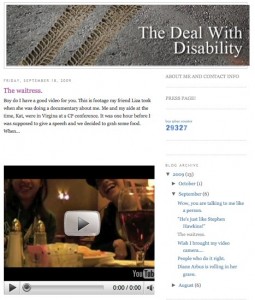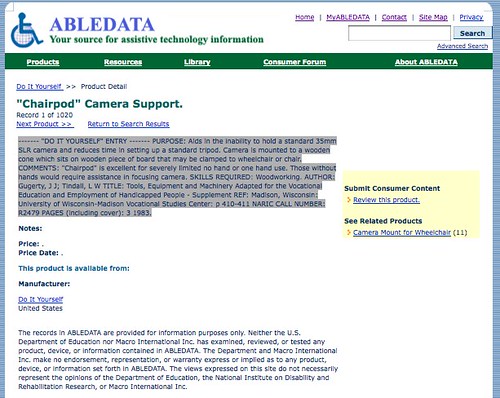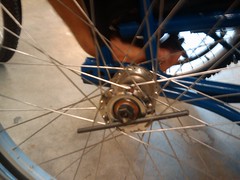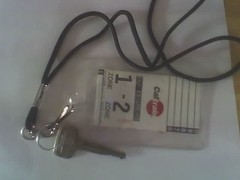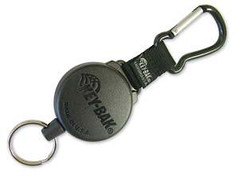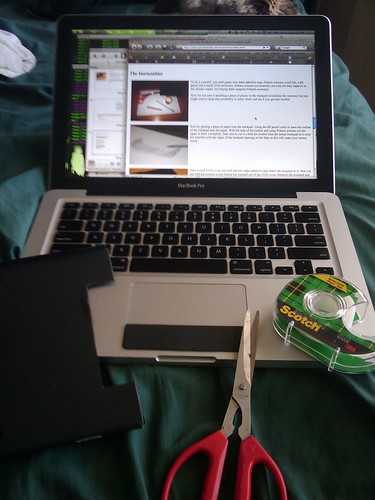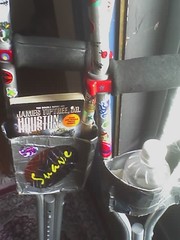This weekend I’m going to be in a conference space in which the women’s restroom door has a sign that is printed with the word “WOMEN” and then something in Braille. It is printed-on and totally flat. Yeah. Someone made that.
My plan is twofold.
I shall arrive at the conference with a small tube of superglue. I will use the superglue surreptitiously to HACK THE BRAILLE by dotting its paint with small bumps of fast-hardening superglue. Don’t worry. I’ll guard it till it hardens so that no one will be glued to the restroom door.
As an added bonus, I’ll photograph the flat braille, and start a flat braille Tumblr. That should be good for some excellent laughs!
Talk about missing the point!
We need more organized and more permanent repositories for open-sourcing and open licensing inventions, adaptations, and mods for access and mobility stuff. I worry that the inventors we do have will have their work be even more ephemeral on the web than it was in the days of pamphlets and small press books (that are just weeded nowadays by most public libraries.) This sounds grim, but say you documented your great one-button invention with all the electronics diagrams, photos, and so on. What happens when you die? Your site and its info will wither eventually. This is why I want to encourage folks to Creative Commons license their works. License the designs and plans to be as public and free and open as possible. Then others can gather and archive them, not just for an archive but for the general public in perpetuity.
I do want to give a nod to the hard work that went into projects like the AbleData DIY listings. Though many of them don’t include the actual details of how to make something, they at least have references that may help a person find the details. It must have been copyright law, or fear of it, that limited what the AbleData DIY project could do and share. The Do It Yourself listings used to be a bit more exposed, but now are only findable in a roundabout way. Here they are, all 1000+ of them:
http://www.abledata.com/abledata.cfm?pageid=113582&orgid=109086
At some point I scraped them with a bit of python, but here they are all as one page. They are easily copied, pasted, or saved as one giant document. Take a look!
Poking at a random entry, WRIST STRAP PICK.
PURPOSE: Pick for persons with contracted or amputated fingers or flaccid hand tone. Large flat and elongated plastic pick has an elastic cuff. Velcro strap adds support and adjustability. Pick can be rotated to the dorsal or ventral side of the hand. Strumming is done with arm movement. Includes drawing.
SKILLS REQUIRED: Assembly.
AUTHOR: Clark, C; Chadwick, D.
TITLE: Clinically Adapted Instruments for the Multiply Handicapped, A Sourcebook.
REF: Book: St louis; Magnamusic-Baton: p 26. NARIC CALL NUMBER: R0272. 1980.
I looked for Clinically Adapted Instruments in WorldCat, which shows that this book is in 236 libraries. Most of them are university libraries. So it is not something you would find anymore (if ever) in your public branch library. You can buy it on Amazon for 20 bucks though.
It would be awesome to get all the books like this, scan them, and put a giant wad of PDFs up somewhere. I do not mind breaking the copyright on some obscure book from 1980 and its kin. Though I could make a bit of effort to find the rights holder. This information should be as accessible and widely spread as possible!
Howdy! Is this thing on? There is now a mailing list for hacking wheelchairs, scooters, powerchairs, and generally anything related to mobility or access. We had a couple of meetings at Noisebridge in San Francisco and will likely meet up some more in different locations around the Bay Area!
So, still here, just very busy and not keeping up the blog very well. Instead I was writing about scooter mods on my main blog.
I really like this site, Often Awesome, a group of friends and community members mobilizing to raise money and mobilize help for Tim, who’s living with ALS. Its struck me as a good and useful hack in itself. Put a donation button on your blog and set it up to make it easy for people to give a small recurring donation over a year. While blog tip jars don’t usually see a lot of action, I think the idea of $5 or $10 a month to a friend or fellow blogger in need would be effective.

It seems key to then report on what the money is getting used for, to report on how many people are subscribing, to thank people in a heartfelt way and to set goals to increase subscriptions. So, “If we get 30 more people giving $10 a month, we can afford this particular wheelchair, or van, or whatever” is more effective than just asking for money over and over. Then when that goal is reached, set another one and ask again.
Note that Tim and Kaylan ask for people’s time and for help with specific tasks, for visits and company, for rides to appointments and stuff like that too. They made it really clear what they need and made it easy for people to volunteer for small roles or one time occasions. They got people to throw benefits and donate for auctions. Good idea! It’s a ton of work to coordinate in itself, of course.
If you look at sites like Kiva.org they operate on the same principle. They tell a story and they set a goal that’s easy to imagine. If someone said, “Hey, I live in Ecuador and have kind of a hard time in life and you’re making bank as a web developer in the United States of Amazing Privilege, how about you give me some money to even things out?” I might say “Oh sure, okay” since I’m a socialist at heart anyway. But do I go out and do that spontaneously? No. But if someone said “Hey I want to buy a truck for my business and can afford it if I raise $2000 ” I feel pretty good giving them 20 or a hundred bucks towards that goal and am inspired to do so.
I think about this a lot, since I have a job and like to donate to people online or off. It’s a pleasure after my own difficult years and the help I got from friends, to be the one who buys dinner for friends once in a while or to just paypal a random blog-friend 50 bucks when they have a difficult month and have been eating ramen for way too long.
Tim and Kaylan do a really good job of telling the story of what ALS has been like for them, on the blog and in their videos produced by AllAcesMedia. They make it really clear how much that story has been about their entire community rallying around them.
Not everyone has that level of real life support. But we’re still able to build strong communities online. More of us should try telling those stories, including what we might need and need help to get.
While not everyone can articulate their situation or make a story out of their life, if you are capable of doing it or have help to do it, it might be worth a try.
The times I’ve asked for help online have been pretty minor, things like needing someone to bring groceries for a week or two. Successful, though.
I was thinking about this issue recently also because of Roger Ebert’s post announcing that he was putting some of his content behind a subscription wall. He’ll still write out in public for free, supported by advertising revenue or paid by newspapers, but there’s extra stuff you can see by paying him $5 a month. I worry this will be pointed to by news media as a successful example of the subscription model for content. When in fact it will be successful not because people are willing to pay $5 a month for a writer’s extra blog posts and twitters, but because people like and admire Roger Ebert and want to give him a hand and show him he’s appreciated for his lifetime of entertaining writing and performance and for what he’s put out into the world and will continue to do.

Have you ever donated money online to an individual in a hard situation? Why or why not? Would you ask for help in this way? Have you ever run a successful fundraiser for yourself or something you need for accessibility or help with an impairment or illness? Or do you think I’m way off base in suggesting this tactic to people with disabilities?
Originally posted on my personal blog, but I’ll try to write posts like this on Hack Ability in the future.
My name is Mel, I’m an electrical engineer with a built-in high pass filter (severe bilateral high-frequency sensorineural hearing loss since age 2), and this is my first Hack Ability post.
I also just got a car, and like most young people with cars, I like using my car to go out with friends.
Problem: The vibration of a car’s engine and the car rolling over the road happens to be right around the few frequencies of speech I can hear, which in the past has led to chronic episodes of – ah – educational detours, as friends yelled “GO RIGHT! RIGHT!” and I went “go straight? OK!” and missed our turn. Repeatedly. I’d usually lipread, but turning to lipread passengers is not a particularly great option when you’re going 60mph down a highway. In the dark. In the rain. In Boston.
Solution: Dashmirror!
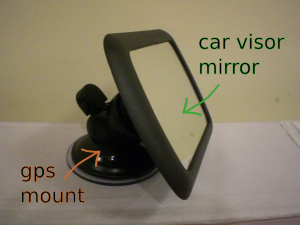
A photo of the dashmirror, with part labels; it's made from a car visor mirror glued to a GPS suction-cup mount.
It’s a simple design. My friend Mark and I made it during lunch one day when we were both visiting Chicago. The parts cost $36.62, but I’m pretty sure you could do it for cheaper.
- $4.39 for the mirror; we found one you’re supposed to clip to your car visor and just removed the clips. The important thing was finding a cheap light mirror of the right size.
- $3.99 for the smallest, cheapest tube of 5-minute epoxy we could find.
- $24.99 for the cheapest generic universal GPS mount in the store. It was still overpriced.
- And then 9.75% Illinois State Tax to make up the remainder.
Assembly instructions: clear off back surface of mirror, choose broadest and flattest attachment for GPS mount, epoxy mirror to that attachment. Like I said, it’s a simple design. The tough part for us was finding the parts. We tried different types of GPS mounts and found a suction cup dampened vibration far better than a clip, so that’s the type I’d recommend; I haven’t yet tried the weighted kind you plonk onto your dashboard.
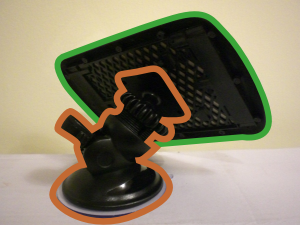
Dashmirror photo from the back, with the different part outlined in different colors to show how it was assembled. It's very simple.
This is actually the third dashmirror I’ve made, but the first I’ve been satisfied with. I cobbled together the first one when I was 17 in order to adorn the extra family car I drove to college (Melmobile v.1.0), and it was awful; there simply weren’t off-the-shelf parts available for mounting visual displays to the dashboard or windshield of your car. Now, thanks to the proliferation of GPS units, they’re everywhere.
Here’s a photo of the dashmirror in action, with my cousin (also named Mark) as the driver/model. Note that it works equally well from the passenger side – no more aching necks from constantly turning towards your driver! You do have to turn on the interior light when it’s nighttime, but you’d have to do that to lipread your driver or passenger anyway.

A photo of the dashmirror being used inside a car.
I use this every day, and love it. I’d like to come up with a more portable design so I can take it on the road with me (when I share rental cars with coworkers and such) – any ideas?
This isn’t a hack, it’s an attitude. I want to link to a post by Hal Finney, a cypherpunk and crypto hacker who works on PGP. Here’s his post: Dying Outside.
Hal points out there is plenty to do with your mind when your body’s not working and there’s assistive technology (and other people) to help us along the way.
People sometimes tell me right to my face that they’d rather die than use a wheelchair, a ventilator, be paralyzed, blind, or lose whatever function it is they are scared of losing, both because they can’t picture solutions to practical problems, and because they “don’t want to be a burden”. If that describes you, go read some of the information at Not Dead Yet:
It’s the ultimate form of discrimination to offer people with disabilities help to die without having offered real options to live.
In his post, Hal says,
I hope that when the time comes, I will choose life. ALS kills only motor neurons, which carry signals to the muscles. The senses are intact. And most patients retain at least some vestige of control over a few muscles, which with modern technology can offer a surprisingly effective mode of communication. Stephen Hawking, the world’s longest surviving ALS patient at over 40 years since diagnosis, is said to be able to type at ten words per minute by twitching a cheek muscle. I hope to be able to read, browse the net, and even participate in conversations by email and messaging. Voice synthesizers allow local communications, and I am making use of a free service for ALS patients which will create a synthetic model of my own natural voice, for future use. I may even still be able to write code, and my dream is to contribute to open source software projects even from within an immobile body. That will be a life very much worth living.
Right on, Hal. You’re fierce! I’m glad you’re determined to not die! Fuck that noise! It makes me proud to see your post!
Free open source speech synthesis software: FestVox I don’t know if this is useful for voice banking and SGDs, but it sounds like a good possibility for people who have ALS.
And the OneSwitch.org.uk site may also be a good resource.
Let’s not forget the totally crucial bit, politics and activism for social change, such as The Community Choice Act which would enable more people to live independently in their own homes.
Here’s an interesting contest for clothing design for people with disabilities. I’m writing to the event organizers to ask them if they’ll think about asking contest submissions to be sent in with Creative Commons (commercial use okay) attribution licences. Then, they could post all the submissions for people to browse, learn from, and use.
It is finally here. We are pleased to announce the launch of the Fashion Moves Garment Design Competition. Register at www.fashionmoves.orgThe goal of this Competition is to introduce Fashion Students around the World, to the opportunities of designing for people with various disabilities.
For an executive who uses a wheelchair, the suit jacket needs to be shortened and winter overcoats designed to be easier to put on and more comfortable to wear
For a teacher who wears a below-the-knee prosthetic, design trousers that are stylish but easy to enable removal of the prosthetic through the day without needing to take the pants off.
For anyone with limited hand dexterity, design shirts and blouses that have a formal look but are easier to do up without assistance.
For women taking part in the Ms Wheelchair America pageants, designing evening dresses that will not tangle in the wheels.
And performance ski suits for the Paralympic skiers who use sit-skis.
The First Annual Fashion Moves Garment Design Competition is now open! Students studying Fashion and Garment Design are invited to register and put their skills to work. There is no fee to register and all reports are submitted by E-Mail or through the website. Students from every corner of the Earth can meet together through Fashion Moves and exchange ideas and forge future business connections.
Please spread the word. If you have a College or a University in your town, forward this note to them, asking them to post it to the Students. If you know someone already studying Fashion or Garment Design, send them a copy to share with their classmates.
Thanks for taking time to visit. Lets use the internet to it’s best purpose and spin this information around the world in days.
Bye for now. I look forward to reading your thoughts on this work.
Ruth J. Clark
Fashion Moves
www.fashionmoves.org
link from D-WILD list for women with disabilities
Fashion Moves looks like a lovely and interesting project. Now, looking at the contest rules, they do seem unlikely to get the point of the power of the Internet and copyleft. Rather than get people to submit to a contest and win a “Grand Prize” of having Fashion Moves make their design into a paper pattern that Fashion Moves then sells… there could be the vision of an alternate business model. One where, for example, all the designs would have patterns up in a free archive or repository, accessible from all over the world. Fashion Moves could put ads on that site, sell its print books wiht the same patterns in it, which people would still buy as gifts and so on. Their helpful designs would reach more people, probably a much more multilingual and international audience, and they could still make money. More information than *one pattern* would reach the world.
This contest and its limitations is a perfect example of old-style thinking about information and scarcity. Its result may be quite positive in that they inspire some fashion and design students to think about the particular needs of people with disabilities. But they miss both a global business opportunity to build a reputation, and an opportunity to build a valuable resource. Their idea, as it is, does not scale as high as it easily could.
Eva’s blog The Deal with Disability is about her encounters with people who talk down to her, assume she can’t think or communicate, or are otherwise a bit hilariously rude while they mean to be helpy. People with disabilities face a constant barrage of these incidents, attitudes, and remarks and usually respond to them in a variety of ways. I think anyone can appreciate that there are moments of annoyance to which a little snark, and political education, are a possible response. To that end Eva shares her short video clips and stories of people who randomly push her wheelchair across the street, talk to her PCA instead of to her, and so on. I was curious about Eva’s gadgets and camera use, so interviewed her by email. Enjoy!
1) What kind of camera do you use for The Deal With Disability posts?
I use a Flip Mino. It’s very small and records 60 minutes of video.
2) What adaptations, if any, does it have to enable you to use it
conveniently?
Really none. I can’t use my hands at all so I just have my attendant set it
up and press the record button. Sometimes doing it this way is easier than
trying to adapt it because it can be so expensive and time consuming. Plus,
since it’s attached to my chair, I am totally in control of what’s recorded.
So adapting that was not high on my priority list.
3) How do you mount it to your chair or other places?
I use an action mount made by the Flip Video company.
It’s made for attaching onto bikes but it works perfectly when strapped to
the handle of my chair.
4) Do you do still photography too? If so what equipment has worked out
for you? Did you modify it yourself in some way, and if so, how?
Yes, I do photography. Again, like the video camera, it would have
been way expensive and complicated to adapt it. Instead, I have worked out
an elaborate communication system with my attendant. I generally tell her
what I want to take a picture of and she she takes it from a variety of
angles and settings. And then I download the images, chose the one I like
and edit them in Photoshop completely on my own using a Headmouse.
5) What other free, very cheap, or DIY hacks have you used, invented, or
thought of?
My most useful DIY invention is my communication system which I
invented when I was 16. Before I used to use my hand on a big letter board
to spell out what I want to say. This was tiring because my control over my
arms is not great. So one day I was like, “hmmmmm what if I attached a laser
pointer to a baseball hat?” I have the most control by far over my head and
neck, so this just made sense to me. Those pen lasers only last like 20
minutes, so the next step was to create a battery pack to attach to the
lazer that would give it more life. I just need to change the batteries
every so often (like once a week), and I have unlimited laser life.
Lots (and I mean LOTS) of people have chided me over not using a
Dynovox or other system. My dad even paid me to learn how to use one when I
was 14 and was pretty surprised when I refused to take it to my first day of
school that year. People who make AAC devices and even disabled people tell
me my letter board makes me too dependent on other people. But for me, the
letter board is the best and fastest way to communicate. It gets people to
interact with me by reading my board. (versus waiting for me to type it
out), and it flows more like a normal conversation. It’s also great because
it is so portable and if necessary, you can make one on a whim. I believe
that the Dynovox, especially for people who can’t write and just use the
pre-programmed buttons, is designed to keep people with disabilities quiet
since they can’t completely express themselves. So my board is by far the
most useful DIY for me.
Thank you Eva for the interview, and for your fantastic blog!
I have invited Eva to post her any time she likes. If you want to join Hack Ability and post about your own DIY projects, you are welcome to join and to email me at lizhenry@gmail.com.
Here is a video clip with a bit about Eva’s own invention for her communication device with board and laser pointer hat.
Here’s a person interested in creating open source camera hardware and software. What else is out there for open source photography hardware?
* A recent announcement of a group at Stanford who have created an open source camera called the Frankencamera, or Camera 2.0. Here’s a press release about the Frankencamera.
The Frankencamera is aimed at researchers in the computational photography community, so they can develop new algorithms and publish them, and at teachers at the university level, so they and their students can play with these algorithms. Our goal is to start distributing cameras within 12-18 months, but the numbers will be small (dozens of cameras), they won’t be cheap ($1K if we’re lucky), and you’ll need to be an experienced programmer to use one.
* Elphel free software and open hardware, wth code on sourceforge, an irc channel and a wiki.
* Apertus open source cinema also looks promising!
Any other free/open source camera hardware and software projects out there? I see potential here both as a model for people creating open source accessible and assistive tech, and as a project that people with disabilities might want to put an oar in, early as possible in the project so that our own specs for usability are considered. If hardware is open source, we as people with disabilities might be able to hack and customize it more easily and to share those hacks with others, than we will be able to hack proprietary cameras.
Reposted from the disability LJ community:
webaim is running their second ever Screen Reader Users Survey. The first survey has been invaluable to web developers who want to write to how PWD actually use extensible technology, instead of writing to how standards designers think we use accessible technology. If you use a screen reader, please take the survey!
The survey mentions :
* Hal
* JAWS
* NVDA (free, open source)
* Supernova
* System Access or System Access To Go
* VoiceOver (Free)
* Window Eyes
* ZoomText
And asks for information on any other screen readers not mentioned. They didn’t list Orca which is free, open source, and scriptable.
Meanwhile, Glenda Watson Hyatt from Do It Myself Blog (Hi Glenda!) asks, So, how do we get programmers going on an open source screen reader for Macs? Let her (and us) know if you hear of any open source screen readers for Mac OS, please!
Some of these hacks may be completely obvious and others maybe not so much, but I thought I’d throw them out there for people to consider. The first and I think most impressive of my projects is a really cheap boom mic. I have been trying to set up my computer for a while now in such a way that I can roll up to it and work on it without being tied to it. My three tethers are my keyboard, my trackball and my headset with microphone. Now two of them are easy enough to solve with wireless keyboard and trackball (or mouse if you prefer). The one that I struggled with was dealing with my microphone that I use for Dragon Dictate NaturallySpeaking.
I tried a microphone on the desk but I couldn’t get the microphone close enough to my mouth so the voice recognition was useful. Which is why I was still using a headset. I looked around the Internet for a boom mic and couldn’t find anything for less than 500 bucks. Which just seemed outrageous to me. So I tried to find a workaround and found something that works for me. I found one of those magnifying lamps like this: http://www.overstock.com/Crafts-Sewing/Slimline-Magnifying-Lamp/3546202/product.html I’m sure that you can use a plain old desk lamp. The important part is the armature with the bend in it. I found a cheap one for about 15 bucks. Bought a regular desk microphone and brought them home. I had the magnifying glass and a lamp removed from the armature, wires and all. Leaving me with a cheap boom. I took the base off the desk microphone so I had a long thin microphone. I mounted the microphone on the end where the magnifying glass used to be. In my case there was enough tension in the bracket that had held the magnifying glass that I was able to just push the microphone into place and I had a boom mic for the cost of about 30 bucks. I haven’t had to, but it might be useful for others to add a little weight to the microphone end of the boom. I’d probably just tape some fishing weights or something similar to the armature to make it a little bit easier to articulate.
I use a mouthstick with my computer to supplement the voice recognition. This is probably too simple but, I thought I’d mention it. A mouthstick can be a pretty pricey item and I just can’t make myself spend that kind of money for a fancy metal or plastic mouthstick. So I go to Home Depot or some similar store and buy a couple of wooden dowels. I cut them to a useful length. Tape the end that will be in my mouth (I use electrical tape, but I’m sure other tapes will do). Then I tape one of those rubber finger cotts that people use when they need to thumb through lots of paper. The rubber end gives some friction and makes typing easier.
My last little gadget is what I call a “quiver” for my straw’s. I buy these extra long straws from a medical supply company that are about a foot long. They’re useful for drinking when you can’t lift a cup. The problem is I didn’t want these straws flopping around loose in my backpack picking up lint or whatever else found its way into my backpack. So I went to a home supply place and bought a length of PVC pipe that the straws would fit in. I bought two end caps to screw on both ends and now I have myself a container for two or three of my straws.
That’s about it for my first contribution to Hack Ability. I hope you find some of them useful.
Washington, DC, is fast becoming a breeding ground for BarCamps, and Accessibility Camp DC has just been announced for October 10, 2009.
The flowering of the Barcamp format in DC is a welcome change from gathering from think tank gatherings for white paper presentations and Congressional testimonies for policy research. I’m looking forward to this event organized by John F Croston III to get to meet some of the ability hackers in DC, start an email list, start projects, and take over the world. You know, the usual Barcamp stuff.
When computer security consultant Sarah Cortes shattered a vertebrae from a 50-foot dive, she hacked her way out of a bad hospital with her iPhone and Twitter.
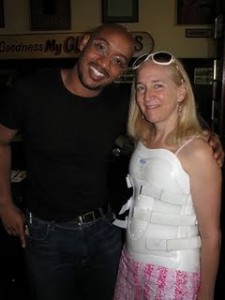
Home and in a Spinal Brace
According to her story, the hospital personnel lied, withheld information from her, refused her any connection to the outside world, tried to put her on narcotics she didn’t need, and pushed her to get immediate reconstructive spine surgery. Their tactics seemed to have the goal of keeping Cortes in the hospital for a lengthy recuperation, paid for by her private insurance.
“Who will be liable if you leave here against medical advice?” a doctor asked, trying to intimidate me into obedience. “Yes, who, indeed?” I demanded to know. He fell silent, aware of the real answer. “If you leave against medical advice, your insurance will pay nothing of your bills so far, and it is in the many thousands! Your transport is medically unnecessary! We are the best qualified to operate on you! If you go to Boston, it is up to you to pay the expense, we cannot authorize it!” All lies, I would later learn.
Cortes contacted friends, community, and doctors through Twitter and her iPhone. She broke through the hospital’s paternalistic refusal to let her leave, and their lies and incompetence, by using Twitter to contact a wide community, a network of people with great resources.
I think that counts as a DIY hack. Though Cortes was not paralyzed, I think that it’s very interesting that her spinal injury factored into the hospital personnel’s attempts to take away her agency — her ability to make her own decisions. They classified her as “disabled” and thus felt free to take over her life in the name of “help”.
Open source speech recognition software needs large samples of transcribed speech recording to make up an acoustic model. The VoxForge project is building acoustic models for English, German, Spanish, French, Hebrew, Italian, Dutch, Portuguese, and Russian. You can contribute to one of these languages from your computer, recording and uploading to VoxForge’s site, or by telephone. It looks very easy to contribute, and it will then be licensed under the GPL.
Most acoustic models used by ‘Open Source’ speech recognition (or Speech-to-Text) engines are ‘Closed Source’. They do not give you access to the speech audio and transcriptions (i.e. the speech corpus) used to create the acoustic model.
The reason for this is that Free and Open Source (‘FOSS’) projects are required to purchase large speech corpora with restrictive licensing. Although there are a few instances of small FOSS speech corpora that could be used to create acoustic models, the vast majority of corpora (especially large corpora best suited to building good acoustic models) must be purchased under restrictive licenses.
Scott at The Blogging Protagonist has posted an incredibly cool electronics project to make a ECG monitor. This is so perfectly in the spirit of Hack Ability, though it doesn’t address an accessibility or assistive tech issue directly, it is all about building a cool thing to give information about your own body.
The goal of this project is to generate an extremely cheap, functional ECG machine made from common parts, most of which can be found around your house. This do-it-yourself (DIY) ECG project is different than many others on the internet in that it greatly simplifies the circuitry by eliminating noise reduction components, accomplishing this via software-based data post-processing. Additionally, this writeup is intended for those without any computer, electrical, or biomedical experience, and should be far less convoluted than the suspiciously-cryptic write-ups currently available online. In short, I want to give everybody the power to visualize and analyze their own heartbeat!
Check out Scott’s heart rate monitor as he plays Counterstrike:
Neat!
(via MedGadget)
I like to keep my knees warm, but don’t want to wear long underwear all year round. Regular legwarmers tend to feel too tight for me and also, a bit itchy. So I cut the toes off some very fuzzy chenille socks and use them over my calves or knees, and under my jeans. A more organized person might stitch around the cut edge, but actually, it’s fine without hemming.
In dollar stores sometimes, you can find these or fuzzy armwarmers and cut off the toe or fingertips. The very loose weave stretches further than regular socks or leg-warmers. They’re about 5 dollars. Without something covering my right lower leg, just the air touching it feels like sandpaper. Sandpaper on fire. An extra layer to stop the cruel knife-like breeze that other people think of as “air” is extremely helpful.
Happy warm knees, or warm calves, to you!
Abledata is a very web 1.0 repository of assistive technology product metadata. It lists thousands of disability and accessibility related *things* and ideas, with citations to the source of the information. There’s a secret corner of Abledata: the DIY assistive tech listings. If you click through “products”, then “non commercial products”, you’ll get to the DIY link.
For example, this camera tripod mount for no-hand or one-hand use. It’s a sentence or two describing the concept of the device or invention, then a bibliographic reference. There’s no plans, photos, designs, links, capacity for tagging. While there’s a “Review this product” link to the side of each page, it doesn’t actually associate with the product or design. There is merely a separate page that gives an alphabetical list of anything that has gotten a review — without threading or real attribution or identity information on the comments. Sooo, like blog comments, or a forum, but a million times worse.
The Abledata DIY repository is a start, and it seems to be useful data. The ideas are useful to think over. Yet I can’t mess with that data in any useful way. There is no API that I can find to pull the data out of the database. My feeling is since it is a public government funded work, the data should be openly accessible and usable.
Then, anyone could build applications to use this data.
As it is, I’m sure I could write a little script to crawl all 41 pages of this data pretty handily and do something with it.
Compare the Abledata site, segregated off into a little silo, with the Instructables Assistive Tech group. Each DIY project is clearly described, with how-tos, photos, video, places for threaded comments and feedback by readers and people who might make the project themselves. Take a look at Build a Motorized Window Blinds Controller. It lists materials and costs (about $15.00). There are 60 people in a lively discussion of the idea including people trying it out and getting advice from the original inventor. The original inventor can easily edit her own project and add clarifications, based on feedback from the crowd. It’s a thing of beauty.
Abledata project may not have the expertise to convert their site into something with crowd sourcing power. (Though, it would be like a 1 week long project to just stuff it all into Drupal and fancy it up a bit.) But they could *easily* make their data available by download or by API. Why not do it? I think it is part of the mentality of control and fear that surrounds disability and assistive tech as “medical” information. Give it up, people, let go of that. Get with the times.
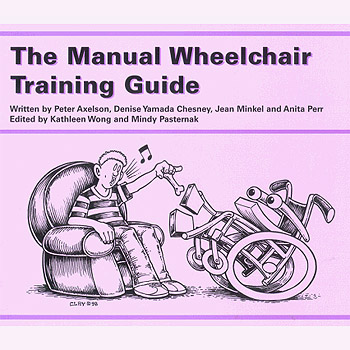
The Manual Wheelchair Training Guide is available as a book for about $15 on Amazon or Spinlife. But you can also get it FREE as a PDF from “Wheelchair University”:
Free PDFs of all the chapters of The Manual Wheelchair Training Guide.
It’s useful, with fitting and maintenance tips, and great advice on how to deal with other people’s attempts (welcome or unwelcome, invited or uninvited) to help. And the cartoons are really cute. It’s like being in 1976 all over again, in a good way.
You’ll have to get the PDF for each chapter separately. The bound book that you can buy online is paperback and has pages that are wider than they’re long, so it lies open flat.
There’s also a Powered Wheelchair Training Guide!
Oneswitch.org.uk has a big set of DIY pages and projects with step by step illustrated explanations of how to make or modify various switches and controllers. Modifying game controllers and remote controls to be usable by sip/puff interfaces or a single button, lever, etc.
Here’s a photo of some of the explanation of how to hack a Rock Band guitar:
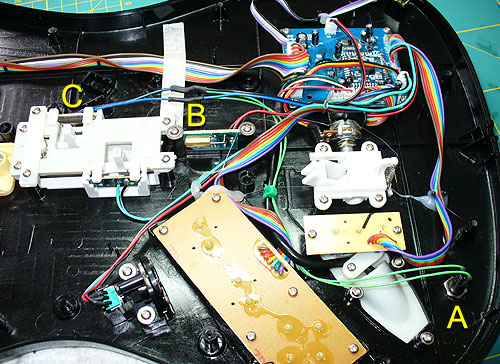
Yesterday I went by San Francisco State and the Whirlwind Wheelchair International workshop to meet up with Alexandra Enders, who I know online and who has a long history in the Independent Living movement, and her friend Marc Krizack.
Instead I found myself in a meeting with her and several folks from WWI, where we talked intensely about the history of the organization, Alexandra’s thoughts on putting DIY assistive tech stuff on the net — we talked for hours. I’ll have to make several posts to zoom in on some of the ideas. Everyone I met was a total rock star.
On the way onto campus my right tire went completely flat. Luckily it was downhill all the way to the Science building. Marc started showing me how to patch a tire. I’d never done it! Bob Incerti ended up re-patching it and helping me get the tire back onto the rim. DIY is all very well but my hands hurt enough to where it was hard to get that tire popped over the rim!
The workshop itself is lovely, with huge amazing complicated looking machine tools, and prototype wheelchairs all over the place. I tried out a Rough Rider model, and then one with gears and levers to push instead of using the rims. The levers take a while to get used to, because while you can go forward or backward nice and fast, turning just a few degrees takes some subtle thought and practice with the reverse knobs. I didn’t get the hang of it and found it very hard to open a door while doing all the small adjustments in position that come naturally in a push-rim chair.
We then had our long exciting discussion. They all shared some common language and history around both independent living and rehab. Despite on and off wheelchair use since 1993 I often don’t have a clue about the world of rehab. But also, there is a cultural disconnect because that information is either not online or is online in ways that aren’t well cultivated or marked or presented, not indexed well or optimized for search engines, so it might as well be in cuneiform for all I can find it.
At our meeting Alexandra talked about her work in the 70s and onward in Rehab Engineering and Assistive Tech. She was involved with the Center for Independent Living in Berkeley, and worked on putting a lot of DIY information into the Abledata database. She has quite a huge private archive of papers and would like to get that information online and into a reliable archive that won’t go away. I suggested Google Books, or getting Google involved in some way; we talked about wikis and content management systems, grants, how to do it, taxonomies, free tagging, and so on.
One thing we didn’t mention, I’m kicking myself for not talking about: Libraries. Might it not be best to work out a donation and grant deal with a big library, but under a good Creative Commons license, and in such a way that people can take the data out and do other things with it?
Ray Grott from SFSU’s Rehabilitation Engineering Technology Project thinks that in some ways it’s good for people to reinvent the wheel, that it is empowering to take control of your environment. And that in working with people with disabilities, he sees every time that people invent nifty stuff. He made the point too that people in developing countries often need low tech solutions that are easily fixable and maintainable. He and I talked a bit about liability, and a group called Through the Looking Glass, which is an organization of parents in Berkeley who write about parenting as people with disabilities and have shared some good information about their inventions.
Bob teaches the Wheelchair Design and Fabrication class at SFSU. He was somewhat quiet in the meeting and had great points about simplifying information, instructions, how-tos, having photos, translations, and so on. But also, and I think more importantly, the difficulties of cultural translation. You can give someone a cookbook and access to Martha Stewart’s kitchen but if they don’t see some cornmeal and a piece of meat and a fire they are not going to know how to cook. So people from the U.S. have exposure to things like bicycles, and have an intuitive background in how gears work, gear ratios, what a sawhorse is good for, what electronics can do, and so on. We can’t assume that background for everyone. And yet, exposure to the ideas and images is valuable. At this point, a lot of people were answering this point by saying “Instructables does it right”.
Bob was also rightly concerned about taxonomy: say we have a bunch of information we scan and stick up on the net. Do we need to decide first what language we use to describe what’s what? Alexandra answered this by talking about tagging and crowdsourcing. The metadata would evolve with the users of the project. I agree with her and yet I think any project would need people to add or cultivate good metadata.
Aaron Weiler, who works at WWI in the production and design process and who has a background as a bike cart hacker, said quite a lot about the appropriate technology movement. I typed up everything he said as he talked, because it was awesome, and I’m going to put that in a separate post.
Keoki is WWI’s new marketing person who seems to have some plans to get their information online and connect with more communities, especially people with disabilities, the Maker and Maker Faire folks, and all sorts of creative people. He is a big fan of Instructables and wondered if their site is accessible from mobile phones.
Marc said that people in locations without much net access might still be able to get to an local internet cafe, engage with this information, and it would be exciting for people with disabilities to participate in DIY projects. He also talked a bit about the idea of universal design.
We discussed how simple inventions or strategies are fairly easy to describe in a how-to. They don’t need specifications or blueprints. More complicated bits of engineering might need exact specs, designs, 3-D CAD stuff, planned design process like the Rough Rider wheelchair has, and relationships with manufacturers. Yet there is some commonality between “the idea of gluing a chess piece onto a button”, “putting your cell phone into a cereal box as an amplifier”, and “an easily maintainable and rugged wheelchair”.
I ended up feeling like we were all talking about a similar vision and project. A central repository, managed by a trustable institution that won’t go away, with the information portable , translatable, and with room for comments and input and tagging. Phase 1 might be simply scanning rather a lot of information and sticking it up somewhere that it could be indexed by search engines. Metadata could be added and good OCR correction done on the PDFs, by people hired from a grant and/or by volunteers coordinated in the manner of open source software projects. Phase 3, probably at the same time as phase 2, would be builders and makers, trying some of the projects and posting feedback, which might just be a photo or two of the build or the result, with a paragraph of description. Phase 4 we can think of as the times people improve on an original design in their subsequent builds.
Also mentioned: Zach from Design Break; the Draper Report; a book by Galvan and Scheers; appropriate technolocy and Shumaker, ITDG technology development group; the UK group Practical Action; Stewart Brand; the WHO term “less resource to settings”; some other org’s term “LRE” or Limited Resource Environment; Peter Axelson’s “How to Use a Manual Wheelchair”; Gary Karp’s “Selecting a Wheelchair”; Gayle Weinstein’s Firefox series of storytelling and story collecting in Appalachia; the RESNA assistive tech journal; Barb Waxman and Marcia Saxton’s accessible gyn guides; the idea that maybe we need a Wiley Wheelchairs for Dummies or an O’Reilly Assistive Tech book.
The new MacBook models have trackpads with multitouch, and there’s no separate button. Instead, clicking down anywhere on the trackpad has the effect of a mouse click. Great in theory, but in practice, my thumb rests on the bottom section of the trackpad, ready to click.
Because it’s touching the pad, my mousing is often interpreted as a zoom or pinch! This is beyond annoying, and makes the computer almost unusable — especially for people with disabilities or who might have a bit of hand impairment from RSI. (If you don’t have RSI now, you *will* after trying to use NeoOffice while your trackpad uncontrollably zooms you from 5% to 300% every 5 seconds!)
The MacOSX Trackpad control panel doesn’t allow turning off the multitouch and zoom functions!
Kustaa “Kusti” Nyholm lets us know that The New MacBook Pro Multitouch Trackpad Sucks — and best of all, exactly how to fix the problems.
First get this free beta software MultiClutch from Will Henderson’s blog. Assign zoom and pinch to a relatively harmless keystroke like Command-B, and half the problem is fixed!
Then follow Kusti’s instructions to make a trackpad button cover.
I took a DVD case, regular scissors, a pen and a piece of paper, and scotch tape. In less than 5 minutes, I had a new trackpad “mouse button cover”. It’s fantastic!
The mouse button cover doesn’t have to fit perfectly; mine doesn’t, and it still works. The laptop lid closes normally. I recommend this hack for anyone who has a new MacBook Pro !
If you have trouble pushing a button, like the flat pushbuttons on an elevator, superglue a chess piece to it. This can also work with switches or other controls. Basically, any time you need to extend a control or make it easier to grasp or shove.

This hack was suggested by some guys from the organization Knowbility who were at my Open Source Disability Tech talk at SXSWi 2009. It sounded like they use this hack fairly often to help people with dexterity issues. It struck me as a beautiful and simple hack, very cheap and easy to execute!
Materials: A chess or other knobby game piece with a flat undersurface; superglue.
If you know how to make, adapt, or hack something that will help out people with disabilities there are a bunch of ways you can spread your idea:
* Post step by step instructions on WikiHow, perhaps in the category Disability Issues.
* Post your hack on Instructables, and tag it disability and “hack ability” as well.
* Link up to your instructions, and post more information if you like, on Disapedia‘s DIY Tips pages.
* Creative Commons or open source license your instructions and plans, and if you’ve got them, designs and blueprints.
* If you have a simple or undeveloped idea, you could post it in the comments on our Ideas page, or on WikiHow in the WikiHow request queue. Maybe someone else will write it up in more detail for you.
Anything might happen to your idea. Someone might commercialize it and try to profit from it but they can’t claim it’s theirs or stop other people from using the idea too. Once your idea is out in the world for free, then anyone can build it, expand it, work on it, and hack it!
